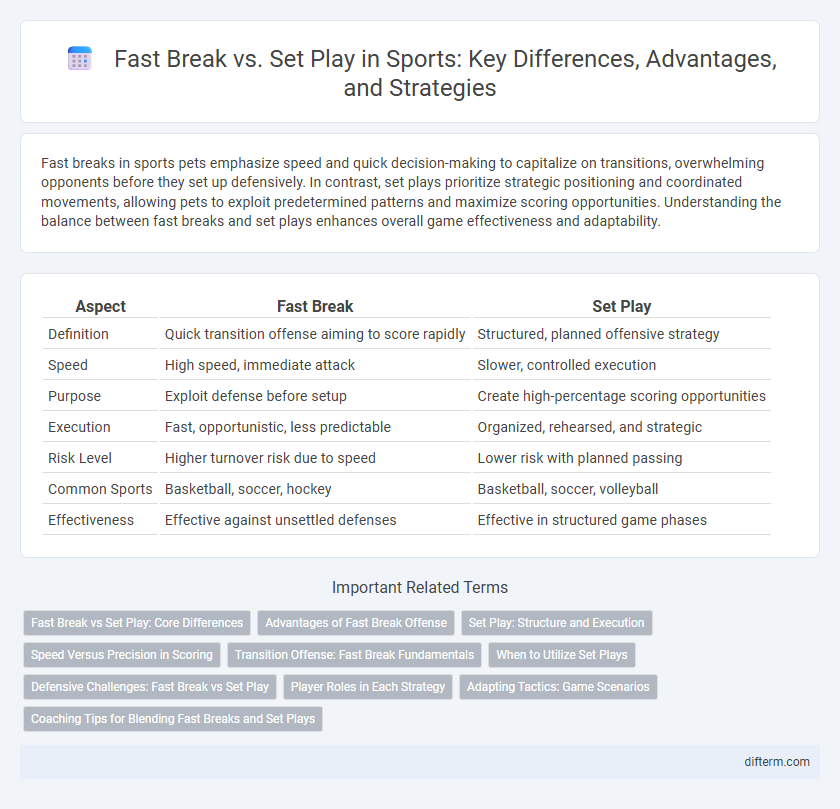Fast breaks in sports pets emphasize speed and quick decision-making to capitalize on transitions, overwhelming opponents before they set up defensively. In contrast, set plays prioritize strategic positioning and coordinated movements, allowing pets to exploit predetermined patterns and maximize scoring opportunities. Understanding the balance between fast breaks and set plays enhances overall game effectiveness and adaptability.
Table of Comparison
| Aspect | Fast Break | Set Play |
|---|---|---|
| Definition | Quick transition offense aiming to score rapidly | Structured, planned offensive strategy |
| Speed | High speed, immediate attack | Slower, controlled execution |
| Purpose | Exploit defense before setup | Create high-percentage scoring opportunities |
| Execution | Fast, opportunistic, less predictable | Organized, rehearsed, and strategic |
| Risk Level | Higher turnover risk due to speed | Lower risk with planned passing |
| Common Sports | Basketball, soccer, hockey | Basketball, soccer, volleyball |
| Effectiveness | Effective against unsettled defenses | Effective in structured game phases |
Fast Break vs Set Play: Core Differences
Fast breaks emphasize speed and quick transitions from defense to offense, exploiting numerical advantages before the opposing defense organizes, resulting in higher scoring efficiency. Set plays rely on structured, pre-planned offensive strategies involving precise positioning and timing to create high-percentage scoring opportunities against well-prepared defenses. The core difference lies in the spontaneity and rapid execution of fast breaks versus the methodical, tactical approach of set plays.
Advantages of Fast Break Offense
Fast break offense in basketball capitalizes on speed and quick transitions, creating scoring opportunities before the defense is set, often leading to high-percentage shots. This strategy exploits defensive disorganization, increasing the likelihood of fast, uncontested baskets. Teams utilizing fast breaks benefit from increased scoring efficiency and momentum shifts that can demoralize opponents.
Set Play: Structure and Execution
Set plays in basketball emphasize structured offensive execution, designed to create high-percentage scoring opportunities through coordinated player movements and predetermined tactics. These plays rely on precise timing, effective communication, and strategic positioning to exploit defensive weaknesses, often involving screens, cuts, and ball reversals to generate open shots. Mastery of set plays requires rigorous practice and discipline, enabling teams to maintain control and consistency in scoring during critical game moments.
Speed Versus Precision in Scoring
Fast breaks capitalize on speed, pushing the pace to exploit defensive disorganization, often resulting in higher-percentage scoring opportunities before the defense sets. Set plays emphasize precision, utilizing structured movements and timed passes to create optimal shot conditions against organized defenses. The balance between speed and precision influences scoring efficiency, with successful teams adapting fluidly between rapid transitions and calculated execution.
Transition Offense: Fast Break Fundamentals
Transition offense capitalizes on quick ball movement and spacing to exploit defensive gaps before the opponent sets up, often resulting in higher-percentage scoring opportunities. Fast break fundamentals emphasize immediate outlet passes, sprinting lanes, and effective decision-making to outpace defenders and create open shots. Mastering these elements contrasts with set plays, which rely on structured positioning and timing rather than speed and spontaneity.
When to Utilize Set Plays
Set plays are most effective during critical moments in a game where precise execution and strategic positioning are essential to break down a well-organized defense. Coaches utilize set plays to exploit specific defensive weaknesses, create high-percentage scoring opportunities, and manage the game tempo, especially in close contests or late-game situations. Using set plays also allows teams to control possession, reduce turnovers, and establish rhythm against aggressive or fast-paced opponents.
Defensive Challenges: Fast Break vs Set Play
Fast breaks present defensive challenges by forcing defenders to react quickly to rapidly changing offensive positions, often leading to mismatches and open lanes. In contrast, set plays allow defenses to organize and set up structured coverage, reducing the likelihood of defensive breakdowns. The quick tempo of fast breaks demands superior communication and transition speed, whereas set plays emphasize strategic positioning and anticipation.
Player Roles in Each Strategy
Fast break emphasizes quick decision-making where guards and forwards lead the transition, exploiting speed to outnumber defenders. Set play relies on structured roles with centers setting screens and shooters positioning for effective spacing and open shots. Player roles in fast breaks center on rapid ball movement and scoring, whereas set plays demand precise timing and coordinated team execution.
Adapting Tactics: Game Scenarios
Fast breaks exploit quick transitions to capitalize on defensive imbalances, often catching opponents off-guard in open-court scenarios. Set plays demand structured positioning and coordinated movements, maximizing scoring opportunities during settled offensive possessions. Effective teams adapt tactics by recognizing game tempo, opponent weaknesses, and player strengths to alternate seamlessly between fast breaks and set plays.
Coaching Tips for Blending Fast Breaks and Set Plays
Coaches should emphasize seamless transitions between fast breaks and set plays by training players to read the defense and make quick decisions under pressure. Incorporating drills that simulate game-speed scenarios enhances players' ability to switch tactics fluidly, maximizing scoring opportunities. Developing communication and spacing skills ensures the team maintains offensive balance while blending fast breaks with structured set plays effectively.
fast break vs set play Infographic

 difterm.com
difterm.com